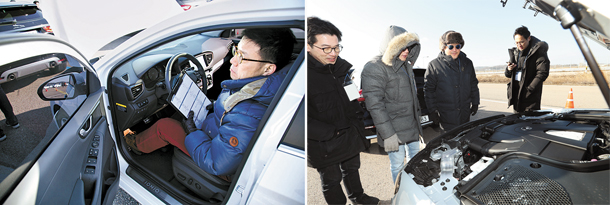How a panel of experts determined the winners

Judges for the JoongAng Ilbo’s Car of the Year awards inspect vehicles at the Korea Automobile Testing and Research Institute’s test-driving course in Hwaseong, Gyeonggi, on Feb. 11. [JOONGANG ILBO]
They were getting ready to be tested by 15 judges including automotive professors, professional racers and journalists. Executives from the Korea Automobile Importers and Distributors Association were also present.
Before starting the actual test drive, judges took a peek under the hood. From the engine to battery, they looked carefully at the internal design of each car.
“Unlike import car brands where the engine compartment is filled with equipment, Hyundai Motor’s Grandeur seems to have a spacious compartment,” said Lee Dae-woon, head of AT&M Consulting.
“Spare room in the engine compartment allows drivers to take out only affected parts when a car breaks down and can help save on maintenance costs,” a Hyundai Motor spokesperson said. “Consumers these days look carefully inside the engine compartment, so we even put special care in painting the space.”
After the inspection, it was time for the high-speed driving test. Judges drove around a 4-kilometer (2.5 mile) course at a speed of over 200 kilometers per hour (124 miles per hour). Unlike on normal roads where it is hard to speed up, all test drivers were allowed to see the full potential of each car that day, even testing the brakes after accelerating the car to full speed.
“Cars of low quality give drivers the feeling that they’re flying in the air when driving at high speeds,” said Jang Jin-taek, head of Car Media, a Korean auto magazine. “When drivers let go of the steering wheel, the car shakes left and right. When turning corners, they feel as if they’re being pushed out of the car. Good cars are just the opposite of that.”
Later in the day, the cars went through a test course that included a sharp curve, a rough road with sunken areas and a section that required rapid acceleration. On the hilly road, some cars were noticeably bumping up and down.
“Cars with high intensity and driving force are competitive in high-speed driving courses, but in this integrated driving course, we can experience detailed performance of each car such as noise level, bounce and suspension,” said Kim Ki-tae, producer of AutoView, an auto media platform.
The JoongAng Ilbo’s Car of the Year award is different from other car awards where assessment is based solely on a vote by car journalists. In this contest, actual driving performance is tested. The purpose of this extra stage is to assess the core performance of each car without prejudice.
That’s why some cars might receive a zero in the first round of assessment, which consists of a presentation by the automaker, but receive high marks in the second round, the test drive. Likewise, there are many cars that receive high points during the presentation but fail to win an award due lackluster performance in the test-drive round.
“The real quality of the car is shown only when a car is pushed to extreme situations,” said Lee Nam-seok, a professor of business at Chung-Ang University. “The driving test held by the JoongAng Ilbo is similar to the performance and durability tests that automakers perform before launching new cars.”
“We don’t give high points just because a car is expensive or sells well,” said Huh Seung-jin, head of the College of Automotive Engineering at Kookmin University. “It is actually important to see how a car’s performance and price are aligned.”
Before the test drive, the first-round presentations were held on Jan. 20. Officials from each company presented on the specs, design and performance of their cars, followed by a question-and-answer session with the judges.
“We expect the sharp observations and feedback from expert judges in the industry to be a healthy boost for Korea’s automotive industry,” said Yoo Ji-soo, president of Kookmin University and head of this year’s judging panel.
BY KIM KI-HWAN, KIM JEE-HEE [kim.jeehee@joongang.co.kr]










with the Korea JoongAng Daily
To write comments, please log in to one of the accounts.
Standards Board Policy (0/250자)